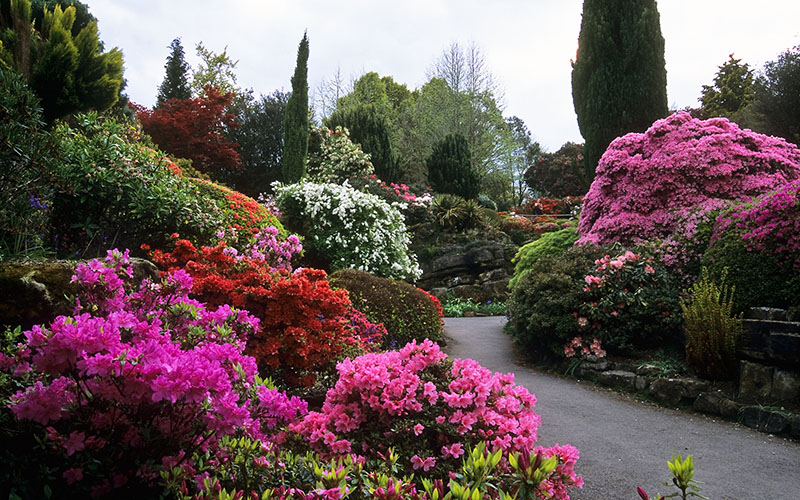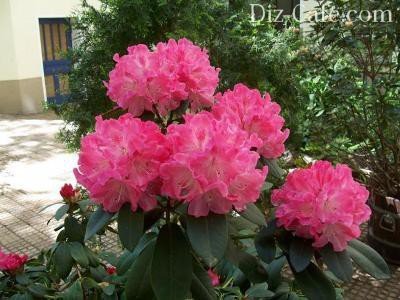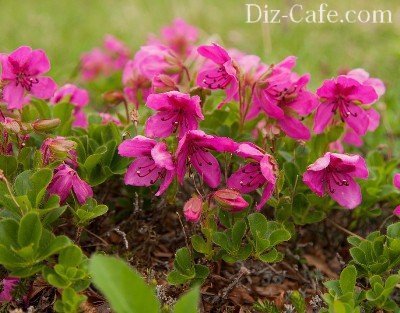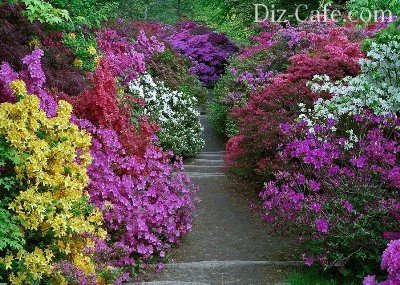5 Possible diseases
Of the dangers that threaten the flowering of rhododendrons, insect pests are isolated: scale insects, spider mites, slugs, snails, flies, mealybugs and bugs. Regular treatments with insecticidal preparations will prevent such invasions.
Among the diseases inherent in these exotic flowers, cancer, rust, and spotting are noted. When signs of the last two lesions appear, plantings are sprayed with copper sulfate. Cancer cannot be cured, so diseased plants are cut out and destroyed. As a prophylaxis, Bordeaux mixture is used, which is treated in early spring and autumn.
In the conditions of the Moscow region, it is advisable to cover rhododendrons for the winter in order to protect them from freezing. Each gardener chooses the method individually. Alternatively, dig in the arcs and pull the non-woven material over the top. Press down from below with a load so that cold air does not blow in. Of course, it is not so easy to grow such exotic things in the middle lane. But frost-resistant hybrids make the task easier. Such representatives adapt well to an unfavorable climate, but with proper care. If you initially competently and responsibly approach the growing process, flowers will decorate any garden for more than one year.
Rhododendron in the Moscow region - features
Sometimes amateur flower growers, fascinated by a beautiful advertising picture, are eager to grow an outlandish bush called rhododendron in their garden. But how often, despite the money, time and effort spent, they are disappointed - the bush on the site looks completely different from the advertising brochure, moreover, it withers every day and, in the end, dies. Is it possible to avoid such a sad ending and grow a heat-loving rhododendron plant in Moscow, for example? Is it possible to grow rhododendron in the Moscow region, in the Leningrad region and other areas of the middle lane? As they say, with the right approach, nothing is impossible.
Planting a rhododendron in the suburbs
First, you need to know exactly which of the rhododendron species can survive the winter near Moscow, since non-cold-resistant species and varieties die from frost even under cover. It is best to plant, of course, deciduous species of rhododendrons: Japanese, yellow, Schlippenbach, Vaseya, Canadian, Kamchatka, Pukhan. Of the semi-evergreen species, the Ledebour rhododendron is suitable, and from the evergreens, the Katevbinsky rhododendron can be grown (as well as its hybrids Alfred, Abraham Lincoln, Nova Zembla, Cunningham White), the short-fruited, golden rhododendrons, the largest and the rhododendron of Smirykirin Smiryel, Smiryelle and his hybrids. The winter-hardy varieties Elvira, The Hague, Mikkeli, bred not so long ago in Finland, have proven themselves well. The hybrids of the Northern Light group Rosie Lights, Pink Lights, Spicy Lights and others winter well in the middle lane.
If you have purchased a winter-hardy rhododendron, then you need to be able to plant it correctly. Firstly, you need to do this in the spring, choosing a semi-shady place no closer than a meter from any other plants. Secondly, buy a special soil for rhododendron or make your own mixture of garden soil, pine needles and peat. A complex mineral fertilizer must be added to the soil. Thirdly, the pit for a rhododendron seedling should be twice the size of the container with the root system of the seedling, and if the soil in the area is clay, be sure to pour a drainage layer of broken brick 15 cm thick on the bottom of the hole.Fourth, do not deepen the root collar when planting - let it remain at the same level as in the container. Be sure to water the seedling after planting.
Rhododendron care in the Moscow region
Planting and caring for rhododendron in the Moscow region is not much different from growing this plant in regions with warmer winters, but there are still differences. We offer you a list of requirements, having fulfilled which, you can well count on success, despite the cool climate of your area:
- rhododendrons grow in acidic humus soils. In the area where the roots take nutrients, there should be no dolomite, ash, lime and other substances that alkalize the soil;
- mulching of the rhododendron trunks is mandatory, especially since it is impossible to loosen and dig up the soil around the bushes due to the horizontal location of the rhododendron root system;
- in the spring, organize the protection of the rhododendron from the sun's rays with a net, gauze or cloth;
- The most important factor for success is deep and balanced watering of the rhododendron: it should receive just as much moisture as it needs, no more, no less. In a dry hot summer, watering is carried out twice a week.
Sometimes at the beginning of autumn, due to warm rainy weather, rhododendrons begin to grow, but young shoots do not have time to ripen and die in winter. To avoid unwanted late growth of shoots, spray the bush in dry weather with a 1% solution of potassium sulfate or monophosphate from a fine spray - this measure will stop growth, stimulate lignification of shoots and the laying of flower buds for the next year. However, after spraying, you should stop watering the rhododendron, even if dry weather sets in.
If you are still worried that your rhododendrons may freeze in winter, arrange for them a shelter by placing a frame of metal mesh around the bush, wrapped in spunbond on top, securing the covering material with rope.
Ratibida: planting and care in the open field
After this article, they usually read
Add a comment
What rhododendrons look like
With the right choice and adherence to some agrotechnical methods, rhododendrons grow well in central Russia, and in the Moscow region as well.

It is a rhododendron shrub belonging to the heather family. In total, there are up to three thousand species, but not all of them are suitable for the cold temperatures of the Moscow region. Among these plants, there are both miniature "shooting" shrubs and rather tall trees up to 30 centimeters in height. But the most beautiful are the so-called deciduous rhododendrons. They spread their branches and thus are great for landscaping.
The flowers of the rhododendron are decorated with lush bunches. They are different in size and shape - it all depends on the variety. So, they can barely reach 2-3 centimeters in diameter, while others grow up to 20 centimeters.
The advantage of rhododendron is that its flowers can have different colors. Summer residents are very fond of creating color compositions by planting rhododendrons of different colors next to each other. So, there are options:
- Purple;
- Red;
- Yellow;
- Orange;
- Pink;
- Crimson;
- Raspberry;
- White.
The shape of the flowers also differs. The most popular are wheel, funnel, bell and tubular options. There is a fruit inside each flower. It is a typical five-leaf capsule that contains small seeds.
The leaves of rhododendrons are ovoid. They successfully frame the plant, forming a graceful crown. There are also options when the leaves are already on the stalks, they are deep-set. The roots of the rhododendron are thin, but they are connected in a large knot. This property makes the transplanting of an adult plant much easier.
Rhododendrons are found in the wild in the countries of Southeast Asia. But thanks to selective methods, they are also grown in Russia. But so that the purchase of a plant does not disappoint, you must certainly know which varieties of rhododendrons for the Moscow region will be most appropriate.
Sponsor of the article: Unofficial informational guide to the “Magnit” loyalty program.
Necessary care
Hybrid rhododendron, like many other varieties, does not require special growing conditions. Here are the main activities:
Watering. The plant is considered to be moisture-loving, but at the same time, it should not be overmoistened. The need for watering must be checked by the state of the foliage. From drying out, the flowering period of the shrub is noticeably reduced. Watering with acidified soft water has a good effect on the condition of the plant. You can use settled. It is enough just a day before using the liquid to pour a few handfuls of high-moor peat into it.
Loosening. It should not be deep, so as not to harm the root system, otherwise the restoration of the azalea will be long
Weeds should also be weeded very carefully.
Top dressing. For rhododendrons, you can use fertilizers that preserve the acidic environment of the soil.
For example, potassium sulfate and nitrate, superphosphate, etc. Substances need to be added with solutions with a low concentration. As for organic dressings, a solution of a rotted mullein is suitable. The tool should be insisted for several days. But horse or pig manure cannot be used. Top dressing is best done 2-3 times per season, from the first weeks of spring to August, when the growing season ends.
Pruning. It will not be needed if the shrub has a uniform and regular shape. If the plant has grown strongly, then all protruding, damaged or dry branches must be cut off. The procedure is best done in early spring. Places of cuts should be treated with paint or garden varnish to avoid contamination. Faded buds should also be removed.
Warming for the winter
It is especially important to carry out this procedure when growing an azalea in Siberia. This applies to most varieties
The procedure is mandatory for young seedlings. The bush must be covered with roofing material, foil or burlap. Foliage and spruce branches are also used. This option is suitable for low-growing bushes. When the temperature is more than 10 ºС, the shelter is removed in the spring.
Rhododendron in the garden
Prevention and control of various diseases and pests is also very important. For the latter, snails and slugs are a common problem. They need to be collected by hand. Spider mites, bedbugs, rhododendron fly and mealybug can also harm. In this case, you cannot do without treatment with fungicidal and insecticidal preparations. It is best to use Diazin, TMTD, Karbofos, Tiram.
As for fungal diseases, rhododendron can suffer from spotting, rust, chlorosis. They develop due to insufficient aeration of the root system and non-compliance with the irrigation regime. With chlorosis, you need to use iron chelate. All rotten branches must be removed. Bordeaux liquid is used for prevention. Other diseases caused by fungi can be treated with fugicides.
An exotic guest at your dacha
Like most of the lushly flowering crops, rhododendron is rarely found in the Russian wild, but grows exclusively under the supervision of gardeners.
Many species take root and feel great only in southern latitudes, so they can be safely grown in the Crimea, Krasnodar Territory or Stavropol Territory. However, some varieties, for example, Daursky or Canadian, develop well in temperate climates, so if you live in the Moscow region, in the Urals or even in the Siberian outback, rhododendron can also decorate your summer cottage with its magnificent flowering.

Literally translated from Latin, "rhododendron" means "rose tree" - and indeed, in its appearance, the plant is very similar to a rose, although it does not belong to rosaceous, but to heather
You are certainly familiar with one of the types of rhododendron - this is the well-known home azalea, which often adorns the windowsills of city apartments. It is distinguished by lush flowering and a variety of shades.
It is impossible to imagine how the relatives of this small plant can reach 25-30 meters in height, although in fact in the Himalayas, Japan, North America, some species grow to such gigantic sizes.
There are also low rhododendrons, which are separate bushes or creeping shrubs that feel comfortable at the foot of the mountains and in the coastal marine areas.

Mountain varieties are small in size and are ideal for organizing alpine slides. For example, the Kamchatka rhododendron is unpretentious, grows only up to 35-40 cm in height and has a bright pink tint.
Among annuals and perennials (and there are about 3 thousand species in total), you can choose a variety whose characteristics are suitable for growing in a certain region.
If you need a special shade - reddish, purple, white or yellow - this will not be a problem either, since the color palette of crops is almost limitless. The flowering culture begins in early spring and continues throughout the warm period.

Thanks to its luxurious color palette, garden azalea can be combined with various types of flowering crops and used for growing in columbariums, rock gardens, multi-tiered flower beds
Growing rhododendron in the suburbs
Novice gardeners are often fascinated by the spectacular sight of the lushly blooming rhododendrons, seeing them in advertisements or in the southern region. But, acquiring such a bush in the middle lane and planting it on their site, many are disappointed in it. It looks far from so spectacular, and sometimes it simply cannot take root and soon dies. But it is still possible to grow a southern ornament in an unusual region for him. Only caring for the plant in this case will have its own characteristics.
Features of landing in the Moscow region
If severe frosts hit in winter, it makes no sense to choose heat-loving varieties for planting. Even the most reliable shelter will not help such rhododendrons. Preference should be given only to frost-resistant species that can survive low temperatures. As a rule, deciduous varieties of rhododendron belong to them: yellow, Japanese, Vaseya, Canadian, as well as Kamchatka, Schlippenbach and Pukhan. The species of Ledebour, partially shedding foliage, also shows itself well. A number of evergreen rhododendrons can also survive extreme cold weather. These include Ketevba, short-fruited, the largest rhododendron, as well as golden and Smirnov. Many hybrids of Ketevbinsky and Smirnov are also highly frost-resistant.
You should pay attention to the group of winter-hardy Finnish varieties, as well as the hybrid group Northern Light
Landing rules
RODODENDRON ❀ How to plant so as not to die? / Garden guide
Having chosen a species suitable for growing, it must be planted on a site in compliance with all placement rules:
- Rhododendrons are planted in spring. For planting, a slightly shady place is chosen, at least a meter away from large landings.
- The dimensions of the planting pit are calculated based on the volume of the container with the rhododendron. It should exceed it by about 2 times.
- If the soil on the site is clay, at least 15 cm of drainage from broken bricks or pebbles is laid at the bottom of the planting hole.
- It is advisable to plant a bush in a mixture that is ideal for it. You can purchase a ready-made composition or mix garden soil with needles and peat yourself. The necessary mineral compositions are also introduced into the soil in advance.
- When replanting a bush in the soil, you should not bury it.The root collar should remain at the same level.
- After transplanting, the bush is watered abundantly.
Care rules in the Moscow region
Caring for a plant grown in the middle lane practically does not differ from the general rules for caring for a rhododendron, but still has a number of features:
Rhododendron should grow in acidic soil rich in humus. The planting area should not include wood ash, limestone, dolomite or other compounds that can make the soil more alkaline. To do this, it is worth imagining the feeding area of the future bush.
After planting, the circle near the trunk of the rhododendron must be closed with mulch. This will retain moisture and protect the plant from weeds. It will still be impossible to loosen or dig up this area due to the high level of occurrence of the roots of the bush.
In the spring, when the sun becomes more active, the plant needs to be covered from its rays.
To do this, you can throw mesh or gauze over the bush.
It is important to follow a specific watering schedule. Rhododendron must receive the required amount of liquid, so the calculation is carried out according to the weather
In hot dry summers, the bush is watered twice a week. If the weather is warm and humid for a long time in autumn, it can activate the growth of young shoots. By winter, such a growth does not have time to grow strong enough and dies at the first severe frosts. Such freezing can weaken the entire bush. To prevent this from happening, the activation of growth should be prevented. To do this, on a dry day, the rhododendron bush is treated with a solution of 1% potassium sulfate or monophosphate using a fine spray. This procedure will reduce the growth rate of the bush and contribute to the woodiness of its shoots. In addition, potassium and phosphorus will help the plant form flower buds for the next year. But after such treatment, rhododendrons stop watering, even if the temperature is high outside and there is no rain.
If there are fears that the plantings will still freeze, even frost-resistant varieties can be additionally covered. For this, a metal mesh frame is placed around the bush. It is wrapped in spunbond and secured with twine. Such a shelter will protect the bush not only from frost, but also from the thickness of snow.
Reproduction
Reproduction of rhododendron is carried out in several ways. The first option is seeds. But this process is long and complicated. It is usually practiced by breeders when creating new varieties. Certain agricultural technology must be followed. For this, seeds must be sown in containers with soil, peat and sand. Then you should equip the greenhouse. The container must be placed in a lighted place. The seeds do not need to be buried in the ground. They can be pre-soaked in water for 24 hours. Moisten the substrate in the container constantly. Open the container every day. The first shoots will appear in about 3 weeks. When leaves are formed on them, a pick can be carried out. In summer, the pots can be taken outside. Plants can only be transplanted into open ground next spring. When grown in this way, flowering will begin only after 4 years.
Rhododendron seedlings
The second way is grafting. Only semi-lignified shoots are used. The ones at the top are best. In length, you need to leave 10 cm. Make a slanting cut at the bottom. Treat the cuttings with a growth stimulant, after which you should wait 15 hours, and then place them in the ground. Then cover with a glass or plastic jar. When the root system is formed, new leaves will begin to appear. Then you can plant copies. But it is allowed to plant them in open ground only after 2 years.
The third way is reproduction by layering. In this case, you need to select the lower branches, make holes in the ground and fix the branches in them. You can attach a heavy stone. Then sprinkle with soil in one place. Water periodically. When the cuttings are fully rooted, they can be detached from the mother bush and transplanted.
Where to plant deciduous rhododendron
When choosing a place where a shrub grows, you should consider:
Rhododendron does not like sunny open areas. The terrain should be partially shaded. It is possible that half of the day the bush is lit, and the rest of the day is in the shade.
In winter, shade should also be in order to avoid diaper rash on the branches and root collar.
It is important to shield the bush from the wind, but a fresh air stream is essential for full growth.
The shrub will quickly die in a place where stagnant water will periodically form. Breeders recommend planting the bushes slightly on a hill so that water does not linger at the roots during rains and melting snow.
What you need to know about planting a rhododendron on the site
Choosing a landing site. This plant prefers partial shade, but does not like drafts. Therefore, the place that you assign to the rhododendron must be protected from the wind. Also, the plant does not encourage direct sunlight and stagnant water. Experienced flower growers say that it is better to plant rhododendron from the north side of the building, and ideally near water bodies where the air is constantly humidified.
It is undesirable to plant rhododendrons next to birches, maples, lindens, alders and willows, since the root system of these trees greatly depletes the soil. But pines are, on the contrary, ideal neighbors for a shrub: their roots are deeply buried, and due to their height, they do not deprive the plants growing near them of light.
Preparation of soil for planting. Rhododendrons love loose, well-drained and humus-rich soil with a pH of 4.0-5.5. But do not overdo it: with an excess of acid, the shrub runs the risk of developing chlorosis. There are several formulations ideal for rhododendron. For example, you can mix sour peat, garden soil and pine bark in a 3: 0.5: 1 ratio and add a little perlite to the soil mixture. The second option is sour peat, coniferous and leafy soil and river sand in a ratio of 3: 1: 2: 1. The third is pine bark, high moor peat and turf soil composted for several years in a ratio of 2: 2: 1.
Well preparation and planting. Since the hole should be 3-4 times larger than the size of the root system of the rhododendron seedling, it is better to make the hole 0.5-1 m deep and 1-1.5 m wide. Gravel or expanded clay is placed at the bottom of the pit and the hole is half filled with prepared soil. The roots of the plant are straightened and planted on top of the soil, then watered well with water at room temperature, the remaining soil is poured on top and tamped. The plant is watered and mulched with pine bark.
This planting method is not suitable for a seedling with a closed root system: it is planted exclusively by the transshipment method.
After about a week, the soil is leveled, leaving a small indentation for easy watering. If there are several plants, then the interval between them should be at least 1 m. Bushes of medium growth are planted at a distance of 0.7-1.5 m, tall ones - 2-2.5 m from each other.


